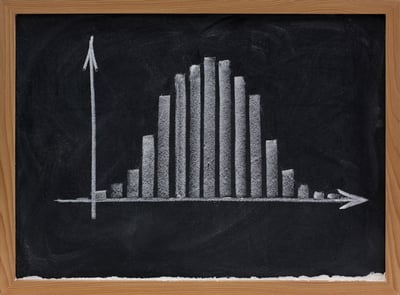by Ken Lopez
Founder/CEO
A2L Consulting
Part 1 of a four-part series on the rise of the midsize law firm in litigation. Parts 1,2,3,4.
I have written about the "new normal" of the legal economy and have even published an ebook focused on pricing strategies and alternative fee arrangements, all part of a trend toward value that major corporations are receiving from their law firms. One other trend that I’ve noticed is that a lot more midsized law firms are now handed big cases to try. It's interesting to watch, since seeing how a midsized firm handles the case feels a lot like 1995 again.
In the 1990s, large law firms were just waking up to the idea of using litigation graphics at trial. It's hard to believe that back then, I spent most of my time convincing this pre-Internet generation that juries wanted to see visuals.
By 1998 or so, A2L Consulting (then Animators at Law) had its first billion-dollar win in part because of the effective use of printed trial boards. That was the same year that we started referring to our work as litigation consulting. Now, almost every case handled by a large firm uses litigation consulting in some form.
Over the past three decades, law firms have figured out that litigation best practices include the extensive use of visual aids, the regular use of a trial technician to manage electronic evidence at trial, and the value of conducting one or more mock exercises. Each of these practice areas has developed in response to specific problems that exist in bench and jury trials alike, and there is an art and science (and about a $250 million industry) that exists around litigation consulting.
So, as more large litigation is pushed into midsize firms as a cost containment measure, I notice something interesting. Most midsized firms just don't know how to use litigation consultants, and what might look like cost savings is going to yield troublesome results later. After all, we figured all of these problems out once in the 1990s, and an industry exists to provide solutions.
So in the spirit of offering the midsized firm, or frankly any firm that is not an AmLaw 50 firm, a solid primer on what's been learned these past 20 years, I offer the following 16 lessons:
1. Using Litigation Graphics Yields Better Results: It's beyond "broad scientific consensus," it's just a fact, Litigation graphics provide better results. This recent 2013 study on the effect of visual evidence on juries [PDF] does a good job of summarizing the science of litigation graphics.
2. Litigators are Generally Not Well-Suited to Do Their Own Graphics: We wrote about this some time ago in a commonsense article called Trial Graphics Dilemma: Why Can't I Make My Own Slides? (Says Lawyer)
3. In-House Graphics Departments Mostly Don't Work: In general, firms do not go to trial enough to give in-house departments real trial experience. This article goes into some detail about in-house graphics litigation departments not working well.
4. Bullet Point Slides Will Hurt Your Case: We write about this often, because it is a big problem that is easily avoided. This is our seminal article on the topic of bullet points, but there are many others.
5. At least 2/3 of your jury will learn visually: A study we conducted in 2003 revealed that about two-thirds of the general public learns visually. It is available as a free download here.
6. Lawyers and Jurors Communicate Differently: The same study revealed something revolutionary too. Lawyers and juries tend to communicate differently. Juries want to see while lawyers prefer to speak.
7. Litigation Graphics Consultants Improve Your Perspective: I've heard it from hundreds of litigators at big firms that one of the things they most appreciate is the fresh pair of eyes that a litigation graphics consultant brings.
8. Showing Your Documents is Not Using Litigation Graphics: We often hear from smaller firms that they have their graphics needs covered because they have someone running their Trial Director database at trial. Actually there is very little overlap between the work talented litigation graphics consultants do and what a trial technician does at trial. In legal terms, generally, litigation graphics people handle demonstrative evidence while trial technicians handle real evidence. You need both to be successful.
9. Skilled Litigation Artists Can Make PowerPoint Do Things You Would Think are Impossible: PowerPoint is a surprisingly powerful tool. In the hands of a skilled consultant, real demonstrative evidence magic is possible.
10. No, your neighbor's son is not well-suited to make your graphics: We spend years taking a great artist and making them a great litigation graphic artist. The two do not automatically go together. In litigation, the goal is persuasion and simplicity.
11. Mixing your presentation forms is critical: I'm not sure this has been extensively studied yet, but I know it's true from my experience. The more you can mix up your presentation mediums at trial, the more you can keep at jury's interest. So, use scale models and use a trial board in addition to PowerPoint to surprise your jury.
12. You Can Actually Learn Big Law Firm Techniques from Your Litigation Graphics Firm: In most cases, a litigation graphics firm will have experienced more trials than nearly any large law firm. That’s just the way it is. Ask them what works.
13. Practice is key: There really is not enough practicing going on in the practice of law. Most people are not normally using visual aids while they are communicating. So, you need to practice this work to make it look natural and not distracting. See 3 Ways to Force Yourself to Practice Your Trial Presentation.
14. Budget for Litigation Graphics at the Beginning: If I were in an in-house position, I would hope to see my outside firm budget $50,000 for litigation graphics work. It might take more or less, but not including this line item in a litigation budget seems unsophisticated at best. Here are some articles on what to expect cost-wise for litigation graphics or animation and even how best to structure alternative fee arrangements with your litigation graphics consultants.
15. Trial is Not the Only Place to Use Graphics: Graphics are showing up in briefs pretty regularly. They are of course used in hearings. Here are 14 Places Your Colleagues Are Using Persuasive Graphics (That Maybe You're Not).
16. There are Very Few Top Notch Litigation Graphics Firms: We are a very small industry. There really are just a small handful of firms that you can trust and rely upon. Get to know them and don't be afraid to work outside of your local area as this is easy remote work. In all likelihood, the best firm for you is not down the street.
Parts 1,2,3,4.







Leave a Comment